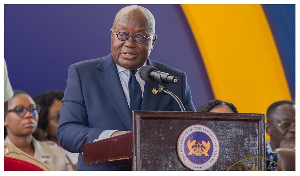There is panic in diamond producing areas in Ghana because of “rumours” that diamonds of Ghanaian origin are banned from the international market (GNA 10/12/06). This panic in the diamond producing communities has come about because Ghana was cited in a United Nations(UN) Panel report a couple of weeks ago as a transit point for smuggled diamonds from rebel-controlled areas of northern Cote d’ Ivoire. This report accused Ghana of “violating United Nations sanctions and an international industry-wide certification scheme”. This piece is about “conflict diamonds” in Africa and the related panic griping the diamond producing communities in Ghana. Rebel soldiers and some rogue African governments have used the proceeds from “conflict diamonds” to further their evil agendas. Are these people the real beneficiaries of “conflict diamonds” in Africa?
Since the 20th century, when the freelance British imperialist Cecil Rhodes sowed tribal strife in South Africa to gain control of rich diamond deposits, diamonds have often been associated with violence and misery in Africa – the very opposite of the advertising images of diamonds companies as symbols of joy and love. Diamonds symbolize so much especially in the Western world where much of it is consumed. Diamond jewelry is a must have for the so-called celebrities in Europe and America. It is the stone most commonly use for wedding rings, diamond is also a powerful token of love, purity, and prosperity. And its value relies heavily on its image of being clean, the most perfect thing that nature provides humanity. But the connection between diamonds and conflicts goes far beyond rebel groups seizing control of diamond-rich areas and selling the precious gems for arms and war supplies. Large diamond companies are also involved in this deadly game, along with traders, transport companies, arms smugglers and financial firms. Many conflicts arise in Africa, where valuable gem diamonds abound. During the 1990s, diamonds fueled the civil war in Angola with terrible consequences. Other diamond-related conflicts have raged in Sierra Leone, Liberia, and the Democratic Republic of Congo. The situation in the Cote d’ Ivoire is history repeating itself. The controversy over "conflict diamonds" involving Ghana puts a lot at stake. Conflict diamonds are not just a public-relations problem; the trade also feed money to a large black market. Some of the profits go to criminal gangs, some to brutal ruling regimes, some to outright terrorists.
Africa is the only continent that has the unenviable record of its mineral wealth been use for the wrong purpose.African states have frequently been hampered by instability partly because the continent is so rich in mineral resources. What had before colonialism been the source for 90% of the world's gold has become the poorest continent on earth, its riches enjoyed by those on other continents. Natural resources on the continent have become a curse and not a blessing. Diamonds from rebel-held mines have raised billions of dollars on world markets to finance insurgencies in Angola, Sierra Leone and the Democratic Republic of Congo (DRC). For years these "conflict diamonds" afforded notorious rebel leaders such as Dr.Jonas Savimbi of the National Union for the Total Independence of Angola (UNITA) and Foday Sankoh of Revolutionary United Front (RUF) in Sierra Leone to arm and equip their armies to terrorize peace loving Africans.
Conflict diamonds are diamonds that originate from areas controlled by forces or factions opposed to legitimate and internationally recognized governments, and are used to fund military action in opposition to those governments, or in contravention of the decisions of the Security Council (UN). Conflict diamonds are a crucial factor in prolonging brutal wars in some parts of Africa. Conflict diamonds have originated from Angola, Sierra Leone, and the Democratic Republic of Congo. Diamonds have also sustained the conflict in Liberia and are a potential revenue source for the rebel group controlling the northern parts of Cote d’ Ivoire. Conflict diamonds, also known as "blood diamonds", have also been linked to armed struggles in the Central African Republic. Investigators have also alleged that underground militant organisations such as al-Qaeda have used the diamond trade to transfer finances outside the gaze of the international banking system. Israeli intelligence also alleges that Hezbollah (a Shiite Muslim organisation based linked in Lebanon) fundraised through diamonds. They used the Lebanese Diaspora in Western and Central Africa.
The diamond industry estimates that conflict diamonds represent 4% of the total trade in rough diamonds. Meanwhile, the underground trade of illicit diamonds is booming. Conflict diamonds are valued “between 4 percent and 15 percent of the world total” and generate annual trade revenues of $7.5 billion. Sierra Leone's decade-long civil war left upwards of 50 000 dead, half a million refugees, and thousands of amputees. The country is currently at the bottom on the UN Human Development Index. A UN Expert Panel report published in December 2000 estimated that in Sierra Leone, the Revolutionary United Front (RUF)'s diamond trade amounted to $25 million to $125 million in diamonds per year in the late 1990s. In Angola the civil war left half a million dead and 86 000 maimed. $3.7 billion in diamonds was pocketed by UNITA and their western backers between 1992 and 1999 alone. In the Democratic Republic of Congo, hundreds of millions of dollars in diamonds are stolen or smuggled out every year.
For over 27 years the world looked on while UNITA led by Dr. Jonas Savimbi, the so-called anti-communist crusader unleashed terror on innocent civilians. According to UN investigators, UNITA used a global barter arrangement to maintain a steady flow of weapons, including tanks, missiles and artillery to its forces in the field. The bartered diamonds allowed Savimbi to equip his UNITA forces. UNITA slaughtered tens of thousands yet Savimbi was a long-time U.S client extolled as a “freedom fighter” by some leading figures of the day, he was even declared to be “one of the few authentic heroes of our time” by the former U.S Ambassador to the UN, Jeane Kirkpatrick. Western banks and corporations profited handsomely from the sale of blood diamonds and other natural resources by UNITA. Presently Angola is still a battle zone. Landmines are maiming and killing innocent civilians on a daily basis. Without the support of the Americans and Apartheid South Africa UNITA would not have survived that long. The cost of reconstructing war ravaged Angola is very huge. The people who suffered as a result of the terror of Savimbi are worst of today, yet for the profiteers; the western banks and corporations, is business as usual.
The trade in conflict diamonds prolonged the wars in Angola and Sierra Leone. Instead of wealth generation and job creation, diamonds have stagnated development efforts and caused immense suffering in the affected African states. On the other hand, diamonds have also contributed immensely to the development of states such as South Africa, Namibia and Botswana.
Some western companies and corporations have continued to make fabulous profits out of conflict diamonds in Africa. In October 2002, a United Nations (UN) Panel of Experts accused three American companies of helping to fuel the war in the Democratic Republic of Congo (DRC). The Panel named Cabot Corporation, Eagle Wings Resources International and OM Group, Inc. as having violated the Organization for Economic Cooperation and Development’s (OECD) “Guidelines for Multinational Enterprises,” a set of international standards for responsible corporate behavior. The Panel’s three-year investigation found that sophisticated “elite networks” of high?level political, military and business persons, in collaboration with various rebel groups, intentionally fueled the conflict in order to retain control over the country’s vast natural resources. The Panel implicated many Western companies for directly or indirectly helping to fuel the war. The conduct of these Western companies has to be measured against internationally agreed standards. Since Western governments and their numerous agents have assumed the role of implementing and policing internationally agreed standards, they should not play double standards.
The U.S State Department, which has oversight for determining whether U.S. companies have breached the OECD Guidelines, declined to undertake an independent investigation into whether these companies (Cabot, Eagle Wings and OM Group ) might have contributed to the war in the DRC. The West cannot have it both ways. They cannot condemn states like Ghana for allegedly allowing “conflict diamonds” to be exported through its ports, whilst tolerating Western companies who fuel these conflicts.
The conflict in the Cote d’ Ivoire is very difficult one and is in Ghana’s own interest to see an end to this conflict. The Precious Minerals Marketing Limited (PMM,) the body charged with the implementation of the Kimberley Process Certification Scheme (KPCS) in Ghana should be up to the task. The diamond industry has a history particularly in West Africa for dealing in conflict diamonds. Our memories of the atrocities in Sierra Leone and Liberia are still fresh. The PMM must intensify education among the diamond dealers so as to protect the corporate image of Ghana. The western border control force should be beefed up and provided with more logistics. Our country’s borders are generally very porous and ‘gangsters’ from rebel controlled northern Cote d’Ivoire can cross into Ghana at time. The past of blood diamonds should be behind us. We in Africa should instead be looking forward to the future, focusing on enhancing the Kimberley Process Certification Scheme, increasing the number of Africans employed in trading, polishing and cutting.




















